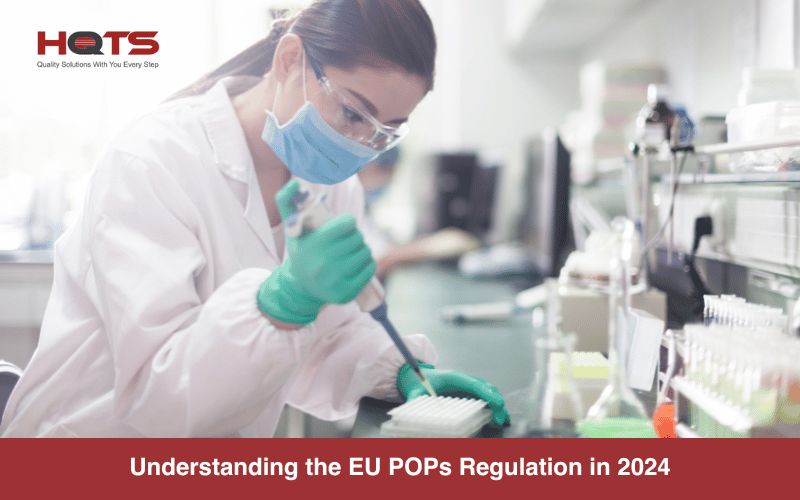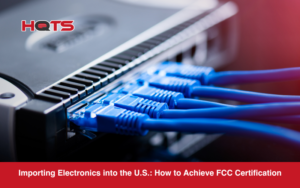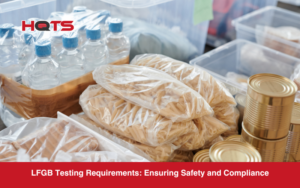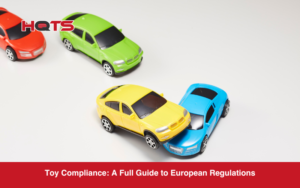Persistent Organic Pollutants, or POPs, pose an environmental and health concern. Not only can they endure in the environment, but they can also accumulate within living organisms. Consequently, it’s important for you to be aware that these chemicals are governed by international agreements and the EU persistent organic pollutants regulation.
Complying with these regulations is important. Especially as any non-compliance may result in legal actions, fines, sanctions, or even the imposition of bans.
In this article, we’ll cover a wide range of topics. From guiding you through what POPs are, their origins, repercussions, and how you can ensure compliance with the EU POP regulation.
What are Persistent Organic Pollutants (POPs)?
POPs stands for Persistent Organic Pollutants. These are organic substances recognised for their enduring presence in the environment. They can accumulate within living organisms, resist breakdown, as well as travel long distances through air/water. Consequently, they pose a threat to both the health of living organisms and the environment.
Due to their long-range dispersal, POPs can endanger and contaminate regions where they’ve not been previously produced or even used. This category includes certain pesticides, industrial chemicals, and by-products of industrial processes.
Exposure to Persistent Organic Pollutants (POPs) occurs through various channels for humans, primarily originating from food, air, and common household items. Even the slightest concentrations of POPs exposure have demonstrated associations with health issues. For example, an increased risk of cancer, reproductive disorders, and immune system alterations.
What Household Items Contain Persistent Organic Pollutants (POPs)?
There are many household items that potentially contain Persistent Organic Pollutants (POPs), and their presence may vary depending on the manufacturing processes and materials used. Some items that are of risk include:
1. Electronics
In electronics, components like printed circuit boards can introduce Persistent Organic Pollutants (POPs). Historically, flame retardants and PCBs, known as POPs, have been used.
2. Furniture
Flame retardants, specifically polybrominated diphenyl ethers (PBDEs), are sometimes found in furnitures. For example, sofas and mattresses.
3. Plastics
Certain plastics have been identified as materials associated with Persistent Organic Pollutants (POPs). These plastics include polyvinyl chloride (PVC) and polycarbonate. They’re commonly used in applications from pipes, flooring, water bottles, to packaging.
4. Textiles
Textiles, such as carpets and curtains, can be treated with per- and polyfluoroalkyl substances (PFAS), which fall under the category of Persistent Organic Pollutants (POPs).
5. Appliances
Older appliances, including refrigerators, air conditioners, and electronic gadgets, may contain components like wiring insulation or capacitors that historically used substances like polychlorinated biphenyls (PCBs), which are classified as Persistent Organic Pollutants (POPs).
It’s important to note that regulations and manufacturing practices vary, and modern standards often aim to reduce the use of POPs in consumer products.
Why Are Persistent Organic Pollutants Restricted?
Persistent Organic Pollutants (POPs) are subject to many strict regulations. This is due to their lasting repercussions on both the environment and human health. They’re prevalent in many industrial processes and everyday products, and possess characteristics that require careful control.
For example, POPs have shown to accumulate in living organisms, travel in the global food chain, and resist natural degradation. Not only does this pose a threat to the environment, but also comes with health risks for humans.
Exposure to Persistent Organic Pollutants (POPs) has shown health consequences, such as:
- Developmental issues in children
- Increased risk of cancer
- Reproductive disorders
- Immune system alterations
- Neurodevelopmental effects
What Is the Regulation on Persistent Organic Pollutants?
The global regulation of POPs is governed by international agreements such as the Stockholm Convention and the Aarhus Protocol. Within the European Union, these regulations are enforced through the POPs Regulation (EU) No 2019/1021. Below, we´ll focus on the EU POPs Regulation (EU) 2019/1021.
What Is the POP Regulation (EU) 2019/1021?
POP Regulation (EU) 2019/1021, enacted by the European Parliament and the Council on June 20, 2019, pertains to POPs. The goal of this regulation is to safeguard the health of humans and the environment within the European Union (EU) by either eliminating or limiting the production and use of POPs.
The regulation strives to minimise, and where feasible, eradicate the release of such substances and manage waste containing or contaminated by them. It’s guided by the precautionary principle and has undergone multiple revisions, with the most recent amendment being Regulation (EU) 2022/2400.
What Substances Are Subject to EU POP Regulation?
EU POP regulation substances falls under various annexes, ranging from subject to prohibition on manufacturing, placing on the market, and use to waste management provisions. You can read more about the details here.
Common EU POP regulation substance categories include:
- Pesticides.
- Industrial chemicals, such as those commonly used in electronic products.
- By-products formed during industrial processes, degradation, or combustion.
Here are some examples of substances subject to the EU persistent organic pollutants regulation:
| Substance | Isomers/Derivatives |
|---|---|
| Endosulfan and its isomers | alpha-Endosulfan, Endosulfan, beta-Endosulfan1 |
| Heptabromodiphenyl ether (Group) | Diphenyl ether, heptabromo derivative1 |
| Hexabromocyclododecane (HBCDD) and all major diastereoisomers identified | 1,2,5,6,9,10-hexabromocyclodecane, gamma-hexabromocyclododecane, Hexabromocyclododecane, alpha-hexabromocyclododecane, beta-hexabromocyclododecane1 |
| Hexabromodiphenyl ether (group) | Diphenyl ether, hexabromo derivative, 1,2,3-tribromo-4-(2,4,5-tribromophenoxy)benzene1 |
| Hexachlorocyclohexanes, including lindane | γ-HCH or γ-BHC, BHC or HCH, (1α,2β,3α,4β,5α,6β)-1,2,3,4,5,6-hexachlorocyclohexane, (1α,2α,3β,4α,5β,6β)-1,2,3,4,5,6-hexachlorocyclohexane1 |
| Pentabromodiphenyl ether (group) | Diphenyl ether, pentabromo derivative1 |
What Is POP Waste?
POP waste is waste consisting of, containing or contaminated by any substance listed in Annex IV to the POP Regulation (EU) 2019/1021
Some examples include:
- Pesticides: DDT, endrin, aldrin, dieldrin, chlordane, mirex, heptachlor, and toxaphene.
- Industrial chemical waste: Polychlorinated biphenyls and terphenyls (PCBs/PCTs), hexachlorobutadiene (HCBD), hexachlorobenzene (HCB), and short-chain chlorinated paraffins (SCCPs).
- Waste containing by-products of industrial processes, including furans, hexabromobiphenyl (HBB), and dioxins.
POP waste is subject to strict rules regarding disposal or recovery. If you require a comprehensive assessment to determine whether your waste falls under EU POP waste regulations, please consult the HQTS compliance department.
What Is the Difference Between POPs and REACH?
The POPs Regulation (EU 2019/1021) and the REACH Regulation (EC 1907/2006) are both EU legislations with the goal of protecting human health and the environment. However, they differ in their focus and mechanisms.
- The POPs Regulation targets Persistent Organic Pollutants (POPs), which are stable, toxic substances that accumulate in living organisms. It restricts a range of substances and includes provisions for waste management and limiting unintentional releases of POPs.
- REACH covers almost all substances used within the EU, whether hazardous or not. Its mechanisms include Registration, Evaluation, Restriction, and Authorisation of chemicals. Companies must register certain chemicals with the European Chemicals Agency, and substances posing serious threats may be subject to further evaluation and possible restrictions or authorisation requirements.
In short, while both regulations aim to protect health and the environment, the POPs Regulation focuses on specific pollutants, including waste management, while REACH has a broader scope and uses various mechanisms to manage substances.
How to Comply with the EU POPs Regulation
Here are five steps to comply with the EU POPs Regulation:
1. Understand the Legislation
Start by reviewing the EU POPs Regulation to understand the specific requirements applicable to the markets where your products are produced, used, or imported. Familiarise yourself with the regulatory framework and any amendments that impact your industry or products.
2. Identify POPs in Your Supply Chain
Adopt proactive communication with your suppliers to identify and assess the presence of Persistent Organic Pollutants (POPs) within your supply chain. Begin by gathering information about the substances used in the manufacturing processes. For additional guidance and support, consider reaching out to the compliance experts at HQTS by clicking here, who can provide consultancy tailored to your specific needs.
3. Explore Alternatives
In the event that you or your suppliers uses POPs, take immediate actions to find viable alternatives to them. Look for alternative substances that align with regulatory compliance and are environmentally sustainable.
4. Stay Updated
Establish a robust system to stay informed about any changes or updates to the POPs list and regulatory requirements. Regularly monitor official channels, industry publications, and authoritative sources to remain current on evolving standards. Last but not least, implement a proactive approach to compliance management.
Conclusion: Persistent Organic Pollutants/POPs Regulations in 2024
Persistent Organic Pollutants, or POPs, are organic substances that persist in the environment, accumulate within living organisms, resist breakdown, and travel extensive distances. Consequently, they pose a threat to both the health of living organisms and the environment.
Because of this, they’re restricted in the EU under the POPs Regulation (EU 2019/1021). It’s important to note that businesses that produce, place on the market, or use persistent organic pollutants (POPs) may face legal actions, fines, sanctions, or bans from EU authorities if non-compliant.
Whether you are a business struggling to understand the POP regulation or need assistance in verifying whether your supply chain complies with POP regulations, please reach out to HQTS’ dedicated product compliance department to receive personalised guidance.




